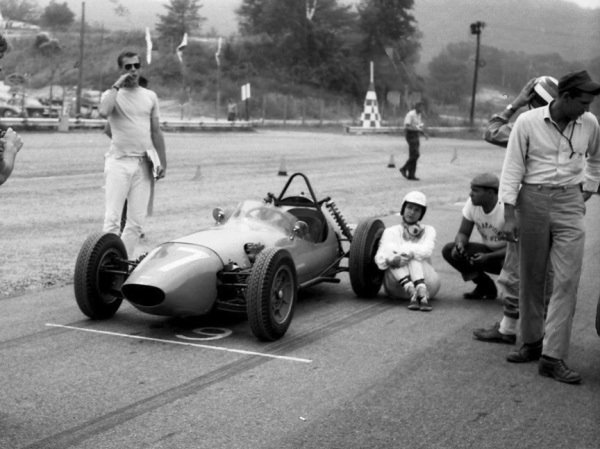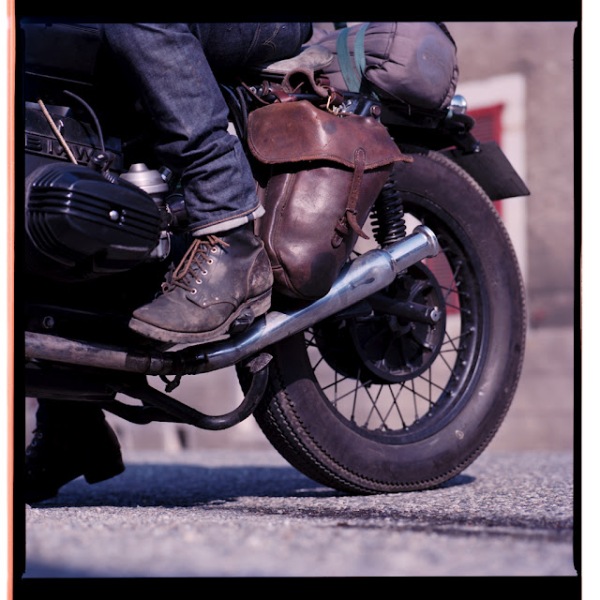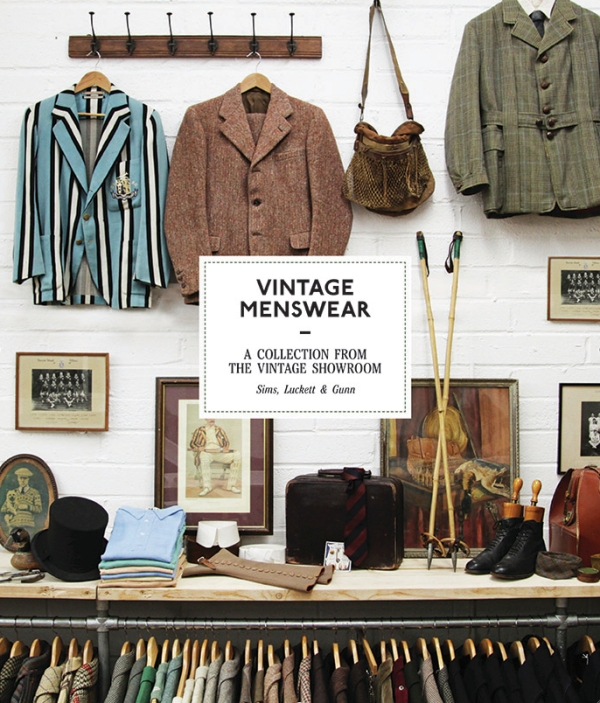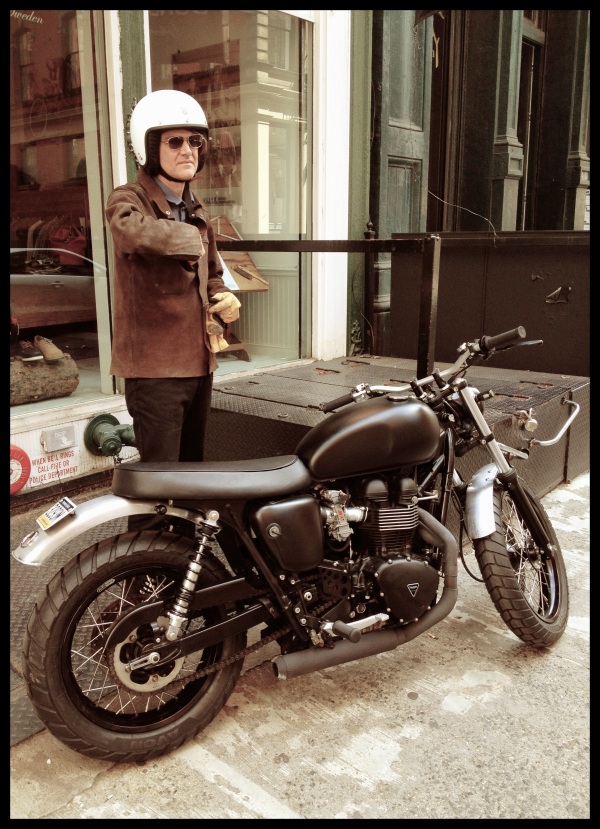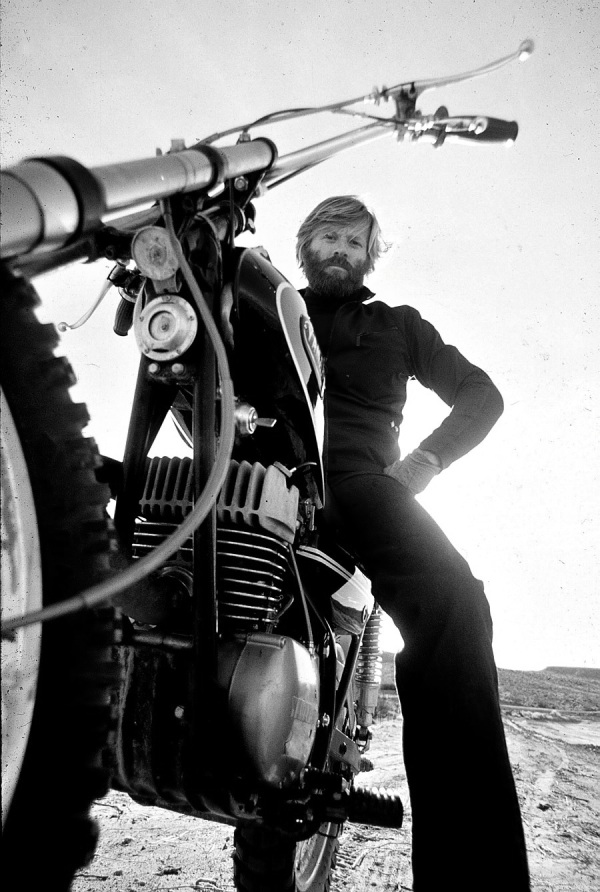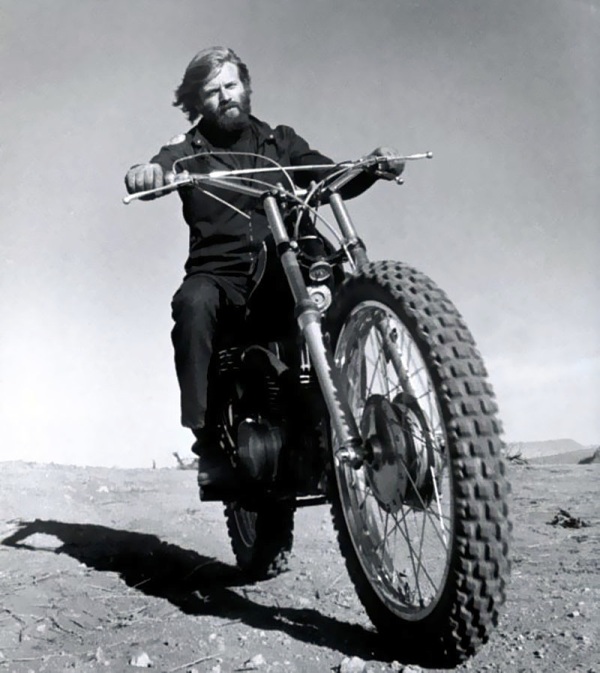-
A great article from 1971 unearthed from the Sports Illustrated archives– Steve McQueen discussing desert bike riding with Bud Ekins & Malcolm Smith, Racing in the 12 Hours of Sebring with Pete Revson, The Great Escape, his son Chad, and much more.
McQueen even recalls exactly when he was bitten by the off-road bug– “Well, I was riding along Sepulveda with Dennis Hopper when we saw these guys bopping and bumping through the weeds near there, off the road. It was Keenan Wynn and another guy on these strange machines, dirt bikes they called them. We asked Keenan if he could climb that cliff. ‘Watch this,’ he says. Varoom! Right up to the top. Dennis and I were standing there with our eyes out to here. The very next day I went out and bought me a 500-cc Triumph dirt bike.”
Read on friends, read on.
-
![steve mcqueen husqvarna]()
Steve McQueen riding his Husqvarna 400 motorcycle. Below is an article from SI magazine, 1971.
-
HARVEY ON THE LAM
* * *
By Robert F. Jones
By any name, Steve McQueen gets all revved up over dirt bikes.
Slamming one across the California Desert is now his Great Escape.
*
The opening scene: California’s Mojave Desert at high noon. Dead silence. Through the shimmering heat waves, Mount San Jacinto seems to writhe on the horizon like a dying brontosaurus. The spines of the cactus at foreground right are in sharp focus, the gleaming spearpoints of a vegetable army. In the shadow of a boulder, sudden movement. A Gila monster raises its beadwork head and flicks its tongue, alert to the distant sound that is just beginning to insinuate itself into the desert’s quiet. A sudden, ululating whine, the invading noise rapidly gains strength as four distorted dots on the horizon weave closer. The dots take on color and shape s they approach: a quartet of red and chrome motorcycles, stunting and racketing through the puckerbushes, their riders vaulting the ridges and slaloming through the cactus at 70 mph. Their ominous, mechanical verve sends the Gila monster– descendant of the dinosaurs– scuttling for shelter. The camers zooms in on the lead rider’s face, sun-blackened and jut-jawed under his helmet. Up music and credits: hold onto your popcorn, folks–
Harvey Mushman rides again!
That scenario, or one like it, takes place nearly every weekend in the desert surrounding Palm Springs. Harvey Mushman is the ocassional pseudonym of Steve McQueen, movie actor and motor sportsman, when he goes a-racing. His companions on those fast, racking transits of the wasteland often include the best of the desert-riding breed: Bud Ekins or Roger Riddell, Mert Lawwill or Malcolm Smith. Now and then a smaller figure on a smaller bike trails behind, slower but only a touch less skillful in his handling of the desert’s harsh nuance– Chad McQueen, the actor’s 10-year-old son.
-
![mcqueen-husqvarna-bell-helmet]()
June 13th, 1971 – Steve McQueen riding his Husqvarna 400 motorcycle in the Mojave Desert — Photo by Heinz Kluetmeier/Sports Illustrated/Getty Images
-
To the serious student (or critic) of motor sports, a movie actor might appear to be an odd choice to illustrate the game of desert riding. Actors. after all, are notorious in their appetite for publicity, and even those who appear in racing fils usually have stuntmen do most of their driving. But Steve McQueen’s racing credentials are quite in order. Last year he proved competence as a sports car endurance racer by placing second in the 12 Hours of Sebring. Aided by the considerable talents of Pete Revson as his co-driver, McQueen drove his half of the race impressively, mixing it up nicely in the corners and clocking lap times within seven seconds of Revson. What’s more, McQueen was driving with his clutch foot in a cast– he had broken his left leg just one week earlier in bike race at Elsinore, Calif. The cast itself cracked during the first 20 minutes of the race “It hurt,” Steve recalls, “and that took a lot of strength away, but mainly it complicated the problems of downshifting through the corners.” Add to that the fact that the McQueen-Revson car was an obsolete Porsche 908, much slower in the straightaways than the top-line Porsche 917s and Ferrari 512s. and McQueen’s finish was even more remarkable. Mario Andretti, who won the race in a five-liter Ferrari, had to shift cars to do so. (His own machine broke down shortly before the end and he commanded another team car that was lying third at the time. At that, Mario only won by 23.8 seconds.) “The motor sports Establishment was scared foofless that I was going to win,” McQueen says now with a grin. “I’m told that Chris Economaki was tearing his hair out and moaning, ‘My Gog, not a movie actor, not a movie actor!’”
But why not? An actor with a rather limited repertoire, McQueen has done a lot to popularize the motor sports he regards as his avocation. In his film Le Mans the romantic cliches of most racing movies are largely avoided, and the kinetic truths of high-speed sports car competition come across with a commanding fidelity. The driving sequences, particularly the crashes of a Ferrari and McQueen’s Porsche 917 (actually a Lola with a Porsche body on the frame), are clearly the best and most realistic ever shot. When they viewed a rough cut of the film at Daytona earlier this year, drivers Jackie Oliver and Vic Elford could find no fault with the footage. “Seeing those shunts in slow motion makes you want to hit the brakes,” allowed Oliver—quite a recommendation from a driver who rarely hits his own.
-
![Steve-McQueen-triumph-Bonneville-T100-Steve-mcqueen-motorcycle]()
The 65ft jump that Steve McQueen’s stuntman (and riding buddy) Bud Ekins performed on a 1962 Triumph TR6 650cc motorcycle in ‘The Great Escape’ almost defied the laws of gravity. It was a heavy bike– a special ramp was built for Ekins to accomplish the jump over the barbed-wire fence. via
-
McQueen’s climactic motorcycle scene in The Great Escape, a 1962 film about Allied POWs in a World War II stalag, was in reality a paean to dirt racing. His slides, jumps, wheelies and even the ultimate “endo” (end-over-end spill) showed a vast audience just what the weekend bike freak sees—and does—at a motocross event. It was a revelation to the uninitiated.
“Most bike flicks in the past concentrated on the outlaw crap,” McQueen says, with some heat. “Hell’s Angels and all of that stuff, which is about as far away from the real world of motorcycle racing as I am from Lionel Barrymore. Brando’s movie The Wild One in the early 1950s set motorcycle racing back about 200 years.”
The real grind of the American Motorcycle Association’s championship circuit is well expressed in Bruce Brown’s superlative bike flick On Any Sunday, which McQueen financed to the tune of $313,000, and the film goes a long way toward rectifying that earlier setback. It shows McQueen’s sometime riding buddy Mert Lawwill trucking his Harley-Davidson from track to track—San Francisco to Columbus to Daytona and back to the Coast, to Sacramento—in defense of his No. 1 plate (which he loses to Gene Romero ultimately). Mainly, though, the Brown-McQueen effort conveys the agility and exuberance of bike riding, particularly off the road, so emphatically that the already swollen market of motorcycle buyers will probably explode as a result.
Insurance hangups have forced McQueen out of sports car racing, but no one can keep him off the motorcycles. “I can’t really say I’m sorry that I don’t race sports cars anymore,” he mused recently at his Palm Springs home. Two tidy Porsche 911s were parked in the driveway, along with six motorcycles. He studied them for a moment. “There’s something awfully final about automobile racing. I learned that when we were shooting Le Mans, if I hadn’t learned it earlier driving. If you foul up in a car often enough, it’s Adios City. Bikes can hurt you sure enough, kill you too, but there’s not as high a fatality rate in bike racing as in cars. I guess it’s the slower speeds and the absence of fire. If you lose it on a bike, you’re clear of the machine when and if it burns. Minus some hide, of course, and dinged up pretty good around the arms and legs and head and shoulders. But basically you’re intact. If you decelerate a car from 200 miles an hour to zero in like 10 yards, which is what happens if you hit a tree on a road course or the wall at Indy, you come out kind of compressed. And if you get knocked out in even a minor shunt and the car starts to burn…well, like I said, it’s kind of final.”
-
![SI Steve McQueen article]()
-
McQueen himself is kind of final about his role as a motor sportsman. “Look, I’m an actor, not a racer. I love bikes for the fun they give me, not the money they might have given me. You can’t earn more than $80,000 a year racing bikes, and you work your tail off doing even that, races every weekend for seven months of the year and from coast to coast. I think that if I’d started young enough in motorcycle racing, I could have been ranked,” says the actor, now 41. “I’ve won my share of races, and I’ve lost them, too. I was in heavy competition with Scooter Patrick for the course lap record at Phoenix, and finally I did it—I set the record. But it’ll be broken. That’s how it goes and how it should go. Sport is not like art. There is no ‘best’ in sports, only ‘getting betters.’”
McQueen’s interest in motorcycles dates back to 1950, when he bought his first bike, “a mean old 1946 Indian Chief. I remember how proud I was of it—I right away went over to see this girl I was dating to show it to her. When she saw it, she said, ‘You don’t expect me to ride around with you on that?’ Well, I sure enough did. The girl went but the bike stayed.”
Those were hungry days for McQueen the entertainer. A tough kid growing up in wartime L.A., he had done time in the Chino, Calif. reformatory (“It was the competitive urge, I think, and I converted it into stealing cars”). The Marine Corps and a stretch in the Merchant Marine straightened him out and showed him much more of the world– Actors Studio, followed by many stage roles, large and small, confirmed him in the direction of drama.
-
![chad steve mcquen le mans]()
That’s a young Chad McQueen going for a ride with dad during the filming of the movie Le Mans in 1970. Chad even went for a ride with Steve in the #20 Porsche 917 that his dad drove in the film. Chad was even allowed to sit in Steve’s lap and hold onto the steering wheel for a short trip down the track. –Nigel Smuckatelli
-
But fast cars and motorcycles remained an alternate mode of expression. During the late 1950s he took off on a bike trip through Cuba. “We were quite a group,” he recalls. “An actor, a poet and a guy who was just plain nuts, or maybe we all were. Hurricane Audrey was sloshing around on the East Coast while we zipped down to Florida. Then we ran from Havana to Santiago, about 967 or so kilometers, as I recall. Batista and Castro were shooting it out down there in the Sierra Maestra, and there were uniforms everywhere. I was still a little wild in those days, particularly when I was on the juice. So what happens? I get thrown in the calabozo. I sent a telegram to Neile Adams, my girl, to send money so’s I could get out. Well, she later married me, but that time she said no. It wasn’t so bad. The guard was a friendly dude, and he’d let me out of the cell so we could have lunch together—cheese and onions and wine—and that hot sun with the smell of the manzanita and the sewers. I suppose that’s the great romantic lure of the motorcycle– it’s a key to adventure.”
Thus far McQueen’s machines had all been “street iron,” outsized, over-chromed jobs that were a terror on the highways but stick-in-the-muds off the road. He learned about dirt riding quite dramatically. “You know that cliff that leads down from Mulholland to Sepulveda?” he asks. “Well, I was riding along Sepulveda with Dennis Hopper when we saw these guys bopping and bumping through the weeds near there, off the road. It was Keenan Wynn and another guy on these strange machines, dirt bikes they called them. We asked Keenan if he could climb that cliff. ‘Watch this,’ he says. Varoom! Right up to the top. Dennis and I were standing there with our eyes out to here. The very next day I went out and bought me a 500-cc Triumph dirt bike.”
-
![steve-mcqueen-husqvarna-01]()
June 13th, 1971 – Steve McQueen riding his Husqvarna 400 motorcycle in the Mojave Desert — Photo by Heinz Kluetmeier/Sports Illustrated/Getty Images
-
Competition quickly followed—club races, hare-and-hound chases across the Southern California wastelands, point-to-points and snow racing in the High Sierra. “It’s rugged riding,” McQueen allows. “I remember one snow race up in the Sierra where I lost it just as I was coming up on this ragged old pine tree. One of the broken-off branches slammed right into my mouth. I was standing there spitting out bark and blood when a course official came up. ‘Are my teeth still in there?’ I asked him. I didn’t want to waste any time taking off my gloves, so he felt around and said that they were loose but still there. I was just dumb enough to jump back on the bike and finish the race. Wow!” He shakes his head, grinning.
McQueen has also ridden in the real enduros, races like Las Vegas’ Mint 400 and the Baja 1,000 from Ensenada to La Paz. In last year’s Elsinore Grand Prix, a race through that small mountain-slope town and its surrounding gulches northeast of San Diego, McQueen was one of 1,500 entrants. As Harvey Mushman, he started well back in the pack but managed finally to snake, bump and vault his way to 10th place overall, while his friend Malcolm Smith was lapping the field for an easy victory. “In my book Malcolm’s the best all-round racer in the world right now,” says Steve. “He’s a gold medal winner in the Internationals, but he still runs all of it— hare-and-hound, trials, long distance. He’s a fine mechanic, and he gets the most out of a bike. He’s got a bad right leg, though he’s not going to tell you about it. I want him to put a brace on it. If he breaks it again, it’s going to be Adios City.”
-
![steve mcqueen Mert Lawwill Malcolm Smith on any sunday]()
Steve McQueen, Mert Lawwill, and Malcolm Smith in Bruce Brown’s– ’On Any Sunday’
-
Intense as his own competitive instincts are, McQueen has found them changing under the influence of the desert– he respects that sternest of geographical gurus, though he is well aware of its quirky vulnerability. Cleat marks left by George Patton’s tanks, training in the desert nearly 30 years ago, are still visible, but rain may follow the new tracks of a dune buggy or a dirt bike and turn imprints into washes. Too many desert freaks, whether cyclists or truck drivers, leave their junk lying around where they dropped it, beer cans, aluminum foil, bottles, the whole undegradable lot, where even a simple tire track ruins the esthetics of this austere, previously wild desert world. “You end up pushing farther and farther into the boonies,” McQueen observes, “trying to escape from other people and their noise and their crap, but then they see your tracks and they follow you. It’s the problem that confronts all of us in a jam-packed world. Who are we running away from? Answer: us. It’s crazy, but what’s the solution?” Dirt riders are discouraged from much of the desert area of California by new laws enacted as a result of the current wave of ecological awareness, but a number of motorcycle parks have been established, mainly around Los Angeles, to give bike people an outlet. This is only a stopgap solution, but McQueen approves of it, for the moment.
As for the desert, “I first began to understand it as a living thing back in my wilder days,” he says. “I was interested in the Indians, and they had given me some peyote. This was way back before the drug culture got started, and people were still serious about the philosophical aspect of the hallucinogens rather than just kicks. Anyway, the peyote really hit me. I took off into the desert on my bike, bound and determined to whip it. I ran flat out, straight into the desert—I was all ego, challenging every bump and every gulch. I don’t know how many endos I turned, plenty of them. The cactus ripped me up, the rocks chewed on my hide, I had sand in my nose and kangaroo rats in my ears. I rode until the bike ran out of gas, and after that I just lay there. It was dead quiet, night falling and my bike making these little crackling noises as the metal cooled and settled. I knew then that not only could I never whip the desert, but that the whole thought of trying to whip it was the most ridiculous idea in the world.”
-
![malcolm smith, steve mcqueen on any sunday]()
Steve McQueen, Mert Lawwill, and Malcolm Smith in Bruce Brown’s– ’On Any Sunday’
-
On this day there was no thought of whipping anything except city-style boredom. McQueen had driven up to Palm Springs from his L.A. offices (he runs a plastics company in addition to his celluloid affairs) to spend a weekend with Chad and a couple of riding pals before embarking on his next film. The movie, Junior Bonner, about a down-and-out rodeo rider— splendid McQueen casting— is directed by Sam Peckinpah, a man with a good eye for such currently unpopular human qualities as toughness, loyalty and contempt for death. McQueen’s desert hideaway, standing on a sun-scorched ridge overlooking the wealth and desiccation of Palm Springs, is some decorator’s dream come surrealistically true. There are kongoni skulls and zebra skin pillows, the mounted head of a Boone and Crockett-class bighorn sheep, a gold-plated Winchester .30-30 “presentation model” hanging on one wall (“much better than that silly little sawed-off Winchester I used in Wanted—Dead or Alive” Steve muses, spin cocking the rifle absently). The refrigerator is full of Cold Duck, Almaden burgundy, Coors beer and Gatorade—this is a dry climate. In the house, at least, it is also a somewhat sad one. McQueen is separated from his wife. “We’ve got our problems,” he admits freely, “and we’re trying to work them out.”
Looking down into the desert from the poolside, McQueen points to the north. “I used to have a little shack out there in the flats—cost me only $102 a month, and I was perfectly happy with it. It was on a wash, and you could just jump on the bike and disappear into the giggle weeds. Oh, well.” Chad is riding around the swimming pool on a bicycle, doing 50-yard wheelies and other stunts, clearly nudging his father to hurry up and get with it for the afternoon motorcycle ride. In everything but his cycle skills Chad is a striking contrast to his father– dark and open rather than blond and curt. He wears braces over his uninhibited smile and has none of that exasperating cocksurety so common to actors’ children.
-
![steve-mcqueen-bud-ekins-triumph-desert-motorcycle-racing]()
“Actor Steve McQueen and his Triumph desert bike in their native habitat.” –Cycle World Magazine, June 1964 via
-
“I’ve tried to raise him as a real kid,” Steve explains. “He likes to ride in the desert and he bought his own bike, a Yamaha 60-cc Mini Enduro, out of his own pocket money. But his schoolwork has to be good if he’s going to ride. I grounded him for eight weeks earlier this year when his grades got sloppy. He’s shaped up nice since then. Christ, riding has got to be good for a kid. I was stealing cars at his age.”
It is egg-frying hot around the pool. Even the water temperature is an incredible 92 degrees thanks to the searing sun, and no one but Chad wants to ride until the shadow of Mount San Jacinto gets a bit taller. McQueen’s other guests are content to lie lizard-like in the sun until then. Roger Riddell is a lean, longhaired dirt rider from L.A. who has taken time off from the two-wheel wars to beat the promotional drums for Bruce Brown’s motorcycle movie. Morris Langbord is dark and hawk-beaked, an “environmental lighting specialist” when he is not racing through the desert. One can only suppose that “environmental lighting” is a euphemism for comedy– Langbord certainly brightens his surroundings with a ready, quippy wit. Just now, in response to a jocular put-down by Riddell, he has dumped a glass of ice cubes on Roger’s chest with an admonishment to “cool it.” Dirt-rider tough, Riddell scarcely flinches. The thirsty sun evaporates the ice in two minutes flat.
-
![mcqueen-baja]()
Steve McQueen, Bud Ekins and the legendary Chevy-powered Hurst Baja Boot, only 2 were ever made.
-
The talk touches, desultorily, upon the topics important to motorcycle men: famous spills and fractures; the relative worth of various shock absorbers, gearboxes and tread-shaping techniques. “Hey, Morris,” says McQueen. “The next time you go by Bud Ekins’ shop I want you to do something for me. You know that 1924 Indian Chief I restored—the one with the side hack? Well, Bud clipped the wheels off of it from me—the original wheels. Every time I come over, he hides them and I can’t steal them back. Maybe if you….”
“No way,” says Morris. “Do your own salvage jobs. My picture’s up in too many post offices already.” Yakety-yak, but their eyes keep watching the sun as it slopes toward the mountain. Finally the angle is just about right. “O.K.,” says McQueen, hitching up his Levi’s like an old gunfighter. “Time for a ride. Let’s get it on.”
-
![steve mcqueen bud ekins]()
Bud Ekins owned and operated a successful Triumph dealership in Sherman Oaks, CA. He had become something of a hero to Hollywood’s young movie actors, who would often hang out at his shop. One of those actors was Steve McQueen. When McQueen bought an off-road motorcycle, Ekins, then the absolute master of Southern California off-road motorcycle racing, coached him in bike control on the desert washes and fir trails of the area. McQueen, in turn, got Ekins stuntman jobs in the film industry. They quickly became very close friends and their attention turned to racing and collecting cars and bikes. via
-
The closing scene: four bikes in the desert. The interplay of the riders as they weave and leap their machines, like stampeding impala. It is a series of interlocking races, or fragments of races, with each rider picking up, without an exchange of words, on the challenge of the next patch of ground. Roger spots a tricky wash with an approach route made even trickier by a staggered stand of manzanita, and as he swerves his bike toward it, Steve and Morris take up the chase. There is only one route over the lip of the wash, and each man tries to reach it first, with Chad in vain but straining pursuit. Collision seems imminent, but Roger gets there just a wheel on top, and the others slip grudgingly into line for the jump. On the next extemporaneous heat McQueen wins the sprint into a sandy corner, and Roger, having come in too deep and now unable to pass, lays his bike on its side and slides clear of the corner in a swirl of spokes and dirt. As he gets to his feet, the alert concern of his companions gives way abruptly to raucous, chivying laughter. “Hey, man, you blew it, man, you road-hog, that’ll learn ya!” Roger flips them the bird, restarts the bike and the chase is on once more. At one point Chad loses a plug over his gearbox and is sprayed with oil. “Yuccchh!” he screams, shuddering as he tries to wipe the oil off. “I can’t stand it!” It is a strange moment, embarrassing to the men. Chad is, after all, still a little boy, with a kid’s sudden incomprehensible hang-ups. Steve reassures him that oil doesn’t hurt and tells him that if he’s going to own a bike, he’s got to make sure that everything on it is buttoned up tight before he rides it. They stuff a chunk of cloth into the hole and roar off once again.
The desert is covered with animal signs. Jackrabbits and ground squirrels have been this way, and there are the tracks of a long-loping coyote. As the day cools, the hawks come out, broad-winged buteos with undersides as pale as the desert sky, swinging in search of dinner. Coveys of Gambel’s quail call from the cool spots. “There used to be antelope around here,” says Riddell during one of the breaks, “but the railroad finished them in one year. They were afraid to cross the tracks, so the herd split up and finally died out. It sounds ominously like a metaphor—but meaning what?” McQueen looks serious during the exchange, perhaps recalling that long-ago run he had made in hopes of conquering the desert, but then he flashes the happy, movie-star grin. “What’ll we do for dinner tonight? How’s about Mexican food? Margaritas, frijoles refritos, enchiladas, peppers…” “Yeah,” says Morris, “and after that a 50-gallon drum of Maalox.”
The long shot that follows puts it all together: four bikes in silhouette, running toward the scattered golden lights of Palm Springs. No music, just the fading, up-and-down cacophony of the engines. Harvey Mushman rides again. And again and again.
-
RELATED TSY POSTS:
STEVE MCQUEEN, RICHARD AVEDON & RUTH ANSEL | HARPER’S BAZAAR, 1965
STEVE McQUEEN DOIN’ IT IN THE DIRT | TRIUMPH DESERT BIKE BY BUD EKINS
STEVE McQUEEN’s 1971 HUSKY 400 CROSS UP FOR AUCTION | BUY IT NOW!
STEVE McQUEEN’s 1971 HUSKY 400 CROSS UP FOR AUCTION | BUY IT NOW!
STEVE McQUEEN REVIEWS THE HOTTEST NEW GT’s | 1966 SPORTS ILLUSTRATED
STEVE McQUEEN ’66 POPULAR SCIENCE | WHAT I LIKE IN A BIKE –AND WHY
STEVE McQUEEN | LE MANS & BEYOND GRATUITOUS 1970s RACING GOODNESS
STEVE McQUEEN | HOLLYWOOD’S ANTI-HERO & TRUE SON OF LIBERTY
REQUIRED VIEWING “BULLITT” | THE GRANDDADDY OF CAR CHASE SCENES
THE TSY FRIDAY FADE | STEVE MCQUEEN’S DUNE BUGGY DAYS
HUSQVARNA | THE SCREAMIN’ SWEDE THAT STARTED A RACING REVOLUTION
1970 12 HOURS OF SEBRING RACE | STEVE McQUEEN’S BRUSH WITH VICTORY
-
The Sports Illustrated Archives– Harvey On The Lam
-
![]()
![]()

